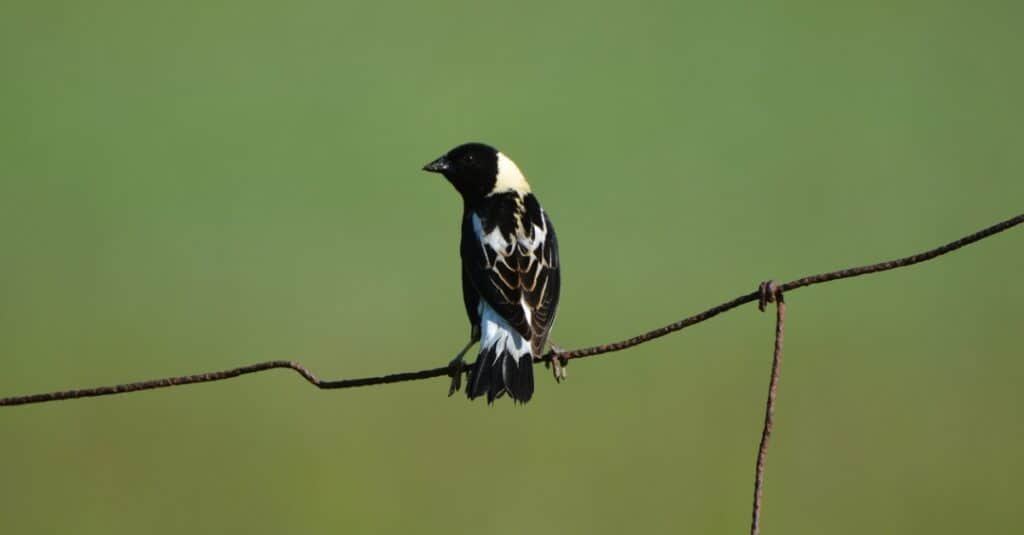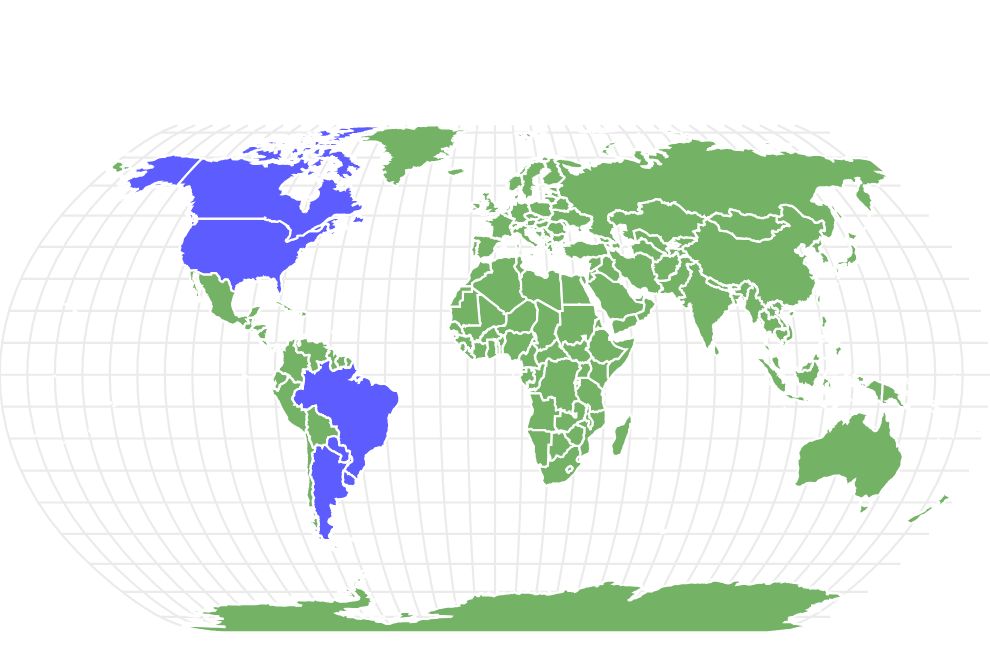Bobolink
Dolichonyx oryzivorus
In spring, the male bobolink is the only North American bird who is dark below and light colored above. This makes identification easy.
Advertisement
Bobolink Scientific Classification
- Kingdom
- Animalia
- Phylum
- Chordata
- Class
- Aves
- Order
- Passeriformes
- Family
- Icteridae
- Genus
- Dolichonyx
- Scientific Name
- Dolichonyx oryzivorus
Read our Complete Guide to Classification of Animals.
Bobolink Conservation Status
Bobolink Facts
- Prey
- Insects and insect larvae
- Fun Fact
- In spring, the male bobolink is the only North American bird who is dark below and light colored above. This makes identification easy.
- Estimated Population Size
- 9.7 million
- Biggest Threat
- Habitat destruction, climate change
- Most Distinctive Feature
- Its song, which sounds like “Bob o’ Lincoln.”
- Other Name(s)
- Armyworm bird, reedbird, rice bird, butterbird
- Wingspan
- 11.5 inches
- Incubation Period
- 10-13 days
- Litter Size
- 3-7
- Habitat
- Wetlands, prairies, grassy fields
- Predators
- Skunks, birds of prey, raccoons, snakes
- Diet
- Omnivore
- Type
- bird
- Common Name
- Bobolink
- Number Of Species
- 1
- Location
- Canada and northern United States in the spring, South America in the winter
- Average Clutch Size
- 5
- Nesting Location
- On the ground among the grass
- Age of Molting
- one week
- Migratory
- 1
View all of the Bobolink images!
“The Long-clawed Devourer of Rice”
Though Bobolink’s scientific name does translate to long-clawed devourer of rice, it is much more than that. This little blackbird, a sign of spring in bird symbolism, also eats lots and lots of bad bugs such as hungry caterpillars. Identification of the male in spring is made easier because he’s the only bird in North America who’s black below and paler above.
Four Incredible Bobolink Facts!
Here are four amazing facts about the bobolink:
- The bird has the nickname of “armyworm bird” because it loves to eat armyworms.
- A flock of bobolinks is called a chain.
- At least one is known to have flown over 1000 miles in one day during its migration.
- Bobolinks use the earth’s magnetic fields to migrate, and their skulls contain magnetic iron oxide.
Where To Find the Bobolink
The bobolink’s range is in the northern United States during the breeding season and in South America in the winter. Countries where it winters include Paraguay, Uruguay, Brazil, and the northern part of Argentina.
When it comes to more symbolism, the bird also represents the prairie, a habitat that’s in decline. Bobolinks used to be found on the prairie and damp meadows, but these locations are uncommon now. Now the bird can be found in wetlands and grasslands where the grasses grow tall. As they are voracious eaters of grain, they can also be found near rice pastures and hayfields.
Bobolink Nests
Bobolinks build their nests on the ground, hoping that they’re hidden by the tall grasses around them. It’s a shallow cup made of stems and lined with finer blades of grass and other plants. The female is responsible for building the nest. Whether the nests are successful depends on where they’re built in the bird’s range. Nests that are built near a forest are preyed upon more often than those built among shrubs, tall grasses, and weeds.
Scientific Name
The bird’s scientific name is the somewhat jawbreaking — Dolichonyx oryzivorus. Dolichonyx is a word derived from ancient Greek. Dolikhos means “long,” and onux means “claw.” Oryzivorus comes from Latin. Oryza means rice and vorare means to “devour.” So the bird’s scientific name translates into “long-clawed devourer of rice.” Bobolink is somewhat onomatopoeic, for many people hear “Bob o’ Lincoln,” in the bird’s song.
Appearance

©iStock.com/Carol Hamilton
The Bobolink’s appearance is unusual for a songbird because the male’s breeding plumage is black on the underside and lighter color on top. This makes identification of him quite easy, even in flight. The non-breeding male, juveniles, and females look much like sparrows. They are mostly light brown with black streaks and stripes. They all have conical bills that are good for cracking seeds and nuts.
Behavior
Bobolinks are gregarious birds and often appear in large flocks. When they come north to nest, the males set up territories that range from one to two acres. Territories can be considerably larger if food is scarce. The male then starts to sing its trademark cheerful and bubbly song. He’ll also do acrobatic feats in flight to impress the females. During their immigration, the birds roost about an hour before dusk, then leave their roosts an hour after dawn. When they’re nesting, they won’t fly away but will run to attract the attention of a predator. Females don’t fly directly to their nests but land at a distant location and walk to them, again to discourage predators.
Bobolink Migration Pattern and Timing
These little blackbirds stay in their nesting range from April to September then head south. The bird is famous for its herculean migrations. In a round trip of over 12,000 miles, it can routinely fly hundreds of miles in a day. It does take time to rest and recuperate on its way from one part of its range to the other. Birds in the eastern range head to the southeast, where they feed on grains before heading to the Caribbean. They rest and feed there before they head to South America. Indeed, the people of the Caribbean referred to bobolinks as “butterbirds” because they were fat from all the rice and grains they ate in the southern United States.
Diet
Bobolinks are omnivores and eat both seeds and insects. They forage on the ground and are especially interested in insects and their larvae during the breeding season when chicks need the animal protein for growth. Chicks are fed caterpillars, butterflies, and moths, sawflies, cutworms, armyworms, and mayflies. Besides rice, they’ll eat the seeds of yarrow, dock, mallow, dandelions, and Canadian thistle among others.
Predators and Threats
Since bobolinks nest on the ground, they are rather vulnerable to predation. As many as 70 percent of eggs and nestlings are lost every year. However, the nests are well camouflaged in high grass, and the parents have developed strategies to lure predators away or trick them. But animals that do manage to prey on bobolinks include:
• Birds of prey
• Skunks
• Snakes
• Raccoons
• Foxes
Many people are surprised to learn that the white-tailed deer, who is supposed to be an herbivore, also eats bobolink chicks.
Not only this but bobolinks are parasitized by brown-headed cowbirds. These birds lay their eggs in the bobolink’s nest and leave, expecting the bobolinks will raise the resulting chicks at the expense of their own.
Though the status of the bobolink is of least concern now, they are threatened by habitat destruction and climate change as prairies are turned into farms and a warming climate causes southern birds to head north to replace the bobolink.
Reproduction, Babies, and Lifespan
Males show up at the breeding area first and establish territories. Depending on the range, this can be as early as April or as late as June. If food is abundant, they’ll sometimes mate with more than one female. Indeed, females will sometimes mate with more than one male, especially if he’s younger than she is. She’ll then raise chicks that have different fathers. First, she’ll build a nest that’s as well camouflaged as she can make it. She’ll avoid building it near trees since trees can give predators a view.
The eggs are also camouflaged, as they’re light brown with gray or cinnamon-colored blotches that are hard to see against the earth. The female lays about four to seven eggs, but if they are lost, she can lay another clutch. She incubates them for between 10 and 13 days. When the chicks hatch they’re fed caterpillars by both parents. They’ll leave the nest after another 10 and 13 days, even though they can’t fly and need to hide in the grass for a few more days to avoid predation. The bird lives about five years, though some have lived as long as nine.
Population
The population is healthy as of 2021. It is estimated to be around 9.7 million birds, and the conservation status is the least concern. Yet the numbers are declining and the bird’s Canadian population might become of concern in the future.
View all 284 animals that start with BBobolink FAQs (Frequently Asked Questions)
Are bobolinks carnivores, herbivores, or omnivores?
Bobolinks are omnivores. They eat both plant materials such as grains and seeds and insects and their larvae.
What is a bobolink?
The bobolink is a type of blackbird that lives in the grasslands and wetlands of the northern United States from Idaho to Maine and southern Canada from British Columbia to Nova Scotia. When it comes to symbolism, the bobolink is a harbinger of spring, much like the robin or the bluebird.
Where does a bobolink live?
The bobolink prefers the prairie habitat but will live and breed in areas of tall grass, especially if they’re next to a field where grass or other grains are being grown.
Why is it called a bobolink?
It’s been given its name because that’s what the song of the male sounds like to people.
Why is a bobolink endangered?
Bobolinks are currently not endangered, but their populations are decreasing. Scientists believe this is due to habitat destruction and climate change. Also, people used to hunt the bobolinks in great numbers because they ate their rice and other crops.
Thank you for reading! Have some feedback for us? Contact the AZ Animals editorial team.
Sources
- Wikipedia / Accessed November 13, 2021
- Penn State University / Accessed November 13, 2021
- IUCN / Accessed November 13, 2021


















